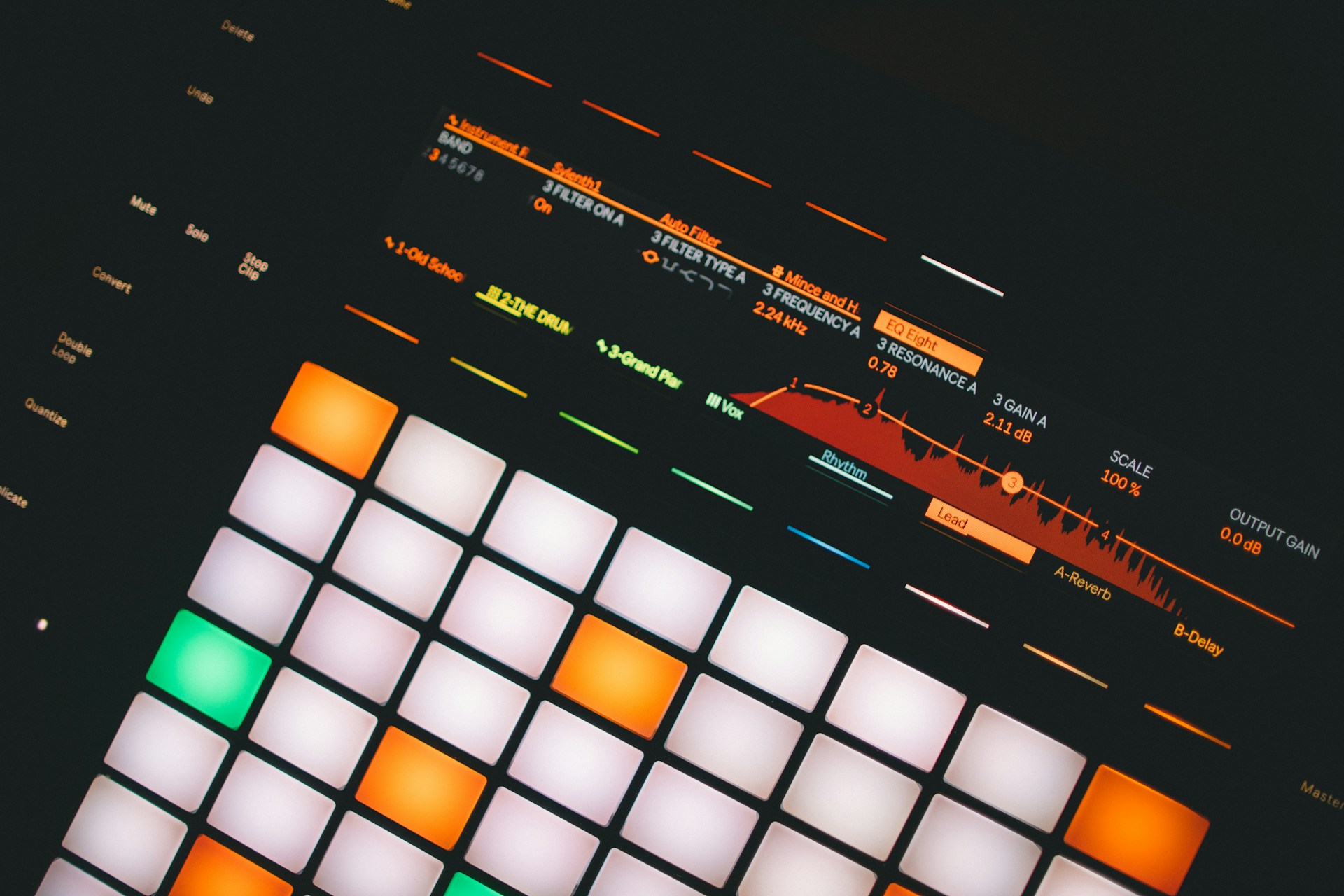
Photo by Vicky Hladynets on Unsplash
Diving into the world of electronic music can be both exciting and overwhelming, particularly for beginners. The key to getting started lies in understanding the essential tools you’ll need for creating, editing, and arranging sounds. Read on as we guide you through how to make electronic music.
Setting Up Your Studio
Creating an effective studio setup is crucial for producing high-quality electronic music. Key components include choosing the right equipment and understanding how to use a Digital Audio Workstation (DAW).
Choosing the Right Equipment
To start, you need a reliable computer. Whether it’s a desktop or a laptop, it should have a fast processor and plenty of RAM to handle the demands of music production software.
Next, invest in good studio monitors. Unlike regular speakers, studio monitors provide a flat frequency response, ensuring you hear the true sound of your music. Studio headphones can also be useful for critical listening and mixing.
An audio interface is vital. This hardware connects your computer to other equipment like microphones and instruments, providing better sound quality and lower latency.
Consider getting a MIDI controller or MIDI keyboard. These devices allow for more intuitive control over your music software, making it easier to play and record melodies, chords, and beats.
Understanding Digital Audio Workstations
Your DAW is the heart of your studio. Popular choices include Steinberg Cubase, FL Studio, Ableton Live, Logic Pro, and Reason. Each DAW has unique features, so choose one that aligns with your workflow and musical goals.
Steinberg Cubase is renowned for its powerful composition tools and comprehensive mixing features, as well as being user-friendly. FL Studio is known for its user-friendly interface and powerful beat-making tools. Ableton Live excels in live performance settings and has a flexible workflow. Logic Pro offers a vast library of sounds and is geared towards Mac users. Reason stands out with its virtual rack of instruments and effects.
Familiarize yourself with the basic functions of your chosen DAW, such as track creation, arranging, and mixing. Many DAWs also support third-party plugins like those from Native Instruments, which can expand your sonic palette significantly.
Fundamentals of Music Production
To successfully create electronic music, you need to grasp the basics of music theory, sound design, and the technicalities of recording and editing both MIDI and audio. These elements form the foundation of your music production skills.
Music Theory Basics
Understanding music theory is crucial. Familiarise yourself with fundamental concepts like scales, chords, and melodies. These elements form the backbone of your compositions.
- Scales and Chords: Learn the major and minor scales, as well as common chord progressions. Major scales generally sound happy, while minor scales give a more melancholic feel.
- Rhythm and Tempo: Focus on time signatures and beats per minute (BPM). Adjusting the tempo can significantly alter the mood of your track.
- Melodies: Crafting strong melodies is key. Start with simple motifs and gradually add complexity.
Sound Design and Synthesis
Sound design involves creating and shaping sounds using synthesizers and samplers. This is where your music gets its unique character.
- Synthesizers: Get familiar with both analog and digital synths. Analog synthesizers offer a warm, vintage sound, whereas digital synths provide more flexibility.
- Effect Plugins: Use plugins like EQ, reverb, and distortion to add depth and texture. Reverb can make your sounds more spacious, while distortion can add grit.
- Samples and Presets: Incorporate samples and presets into your work. These can serve as building blocks or inspiration for your own sounds.
Recording and Editing MIDI and Audio

Photo by Wes Hicks on Unsplash
Recording and editing are essential skills. They enable you to capture your musical ideas and refine them into polished tracks.
- MIDI Controllers: Use MIDI controllers for a hands-on approach to music creation. They allow you to input notes and control virtual instruments.
- DAW: Your Digital Audio Workstation (DAW) is where you’ll do most of your work. Learn the basics of your DAW’s interface and tools.
- Editing Techniques: Master basic editing techniques such as quantisation, which aligns your notes to a grid, and velocity adjustment to control the dynamics of your performance.
By focusing on these fundamentals, you can build a strong foundation for your electronic music production journey.
Arrangement and Composition Techniques
Understanding how to arrange and compose your electronic music is crucial. This involves deciding the song’s structure and how to use effects and textures creatively to maintain listener interest.
Song Structure and Dynamics
When arranging a song, starting with a simple intro sets the tone. Intros typically last between 8 and 16 bars. Verses and choruses follow, often introducing new elements and building energy. Add breakdowns to create tension, often stripping back to minimal elements before building back up.
In genres like house or deep house, bridges and breaks are essential for adding variety. The arrangement often ends with an outro that helps scale down energy levels, providing a sense of closure.
Use dynamics carefully—gradually increase and decrease elements to prevent listener fatigue. For electro or disco, layering is key; multiple elements should work together without overwhelming the core rhythm or melody.
Creative Use of Effects and Textures
Effects and textures add depth and interest to your music. Reverb and delay create space, making elements feel like they exist within a room. Compression helps control dynamics, ensuring no single element is too loud or quiet.
Distortion and modulation effects can be used on vocals or synths to create unique sounds. Experiment with EQ to carve out frequencies, making each element fit better within the mix. Use filters to build tension, especially in breaks before a drop.
Adding textures, such as ambient noises or layered synths, can make your track sound richer. These methods help maintain interest and keep your compositions engaging.
Sharing Your Music with the World
As an electronic music producer, sharing your work is essential to grow your audience and refine your craft. This involves meticulous mixing and mastering, as well as effective promotion to reach and engage listeners.
Mixing and Mastering Best Practices
To create a polished final product, focus on mixing and mastering. Mixing balances the individual elements of your track, such as synths, drums, and bass. Use tools like EQ, compression, and panning to ensure clarity and separation among instruments. Pay attention to the low-end frequencies, especially in genres like dubstep and hip-hop.
Mastering is the final touch, enhancing the overall track’s loudness and tonal balance. A good mastering engineer can make your track stand out on various playback systems. Use platforms like Udemy to improve your mastering skills or consider professional services if you lack the expertise.
Promoting Your Music and Engaging Listeners
Promoting your music requires a strategic approach. Distribute your tracks on major platforms like Spotify, SoundCloud, and Apple Music. Create engaging content such as behind-the-scenes videos or tutorials showcasing your sound design process.
Engage with your listeners by being active on social media. Platforms like Instagram, Twitter, and TikTok can help you connect with your audience and increase your reach. Collaborate with other producers or musicians to tap into their audience. Hosting live streams of your Ableton Live sessions can also attract fans interested in EDM, techno, or future bass.
Conclusion
Embarking on the journey to create electronic music can be both exciting and challenging. Dedication and practice are key to mastering the craft.
Begin with a basic setup: a computer, a Digital Audio Workstation (DAW), speakers, and a MIDI controller. These will form the foundation of your home studio.
Explore different synth plugins to generate unique sounds. Experiment with effect plugins to shape your audio using tools like EQ, compression, reverb, and delay.
Understand the genre you want to specialise in by learning its tempo and beat structures. Listen to a wide range of electronic tracks for inspiration.
Stay engaged with the community. Attend concerts, follow online forums, and participate in workshops to keep your skills sharp and stay updated with new trends.
Don’t be afraid to make mistakes; they are an essential part of the learning process. Keep creating, learning, and refining your tracks.
With patience and effort, you will develop your own unique sound and style in electronic music production.
